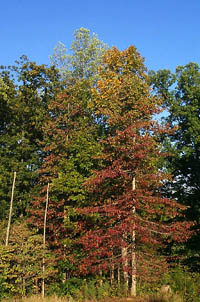Damage from Fall Fires Varied
Damage from Fall Fires Varied

Fall fires in Kentucky burned nearly 10,000 acres of the Commonwealth's forest lands. Cooler weather and timely rainfall extinguished those fires. So now what? What kind of damage will forest land owners find?
"No matter the fire intensity, landowners will see some damage," said Doug McLaren, forest management specialist for the University of Kentucky College of Agriculture. "The hardwood timber of Kentucky trees, such as oak, walnut and ash, take nearly 100 years to mature in un-managed stands. Having a fire, of any intensity, will burn the most economially valued section of the tree."
After a fire, a tree of any age continues to decrease in value as it grows and matures over its lifetime. Trees that suffered damage in fires decades ago will have a lower market value today and in the future.
"The reason for this deceased market value is because trees are damaged at the base from the slow fires that burn along the ground, " McLaren said. "The damage results from the fire first killing the outer protective covering of the bark and then killing the inner life sustaining tissues of the tree."
McLaren said when this happens, the tree is exposed to insects, disease and eventual rot and decay. This will translate into low monetary returns when the crop is sold.
It is important to remember the potential value of Kentucky's hardwood trees is determined by the first sixteen feet of the stem. If this section is damaged, the entire tree's value decreases.
The extent of the damage to a tree is different, depending on the severity of the fire. If the fires damage is extensive, a new forest will regenerate from the seeds and roots in the ground, as well as the seed sources from the surrounding areas.
A forester needs to evaluate less intense damage in other burned stands to make the decision about alternatives that are available to maintain the quality and health in the forest stand. If a damaged stand is mature or close to maturity, harvesting is a potential solution with little economic loss.
"Remember, any fire in a forest stand will create potential tree damage," McLaren warned. "Many stands will again leaf out in the spring, but the damage created by previous forest fires will continue to exist in these stands. A forester easily can determine the extent of fire damage."
If you any questions concerning forest fire damage in your timber stand, or any questions concerning forested properties, contact your local Cooperative Extension Service office for the name of a professional forester in your local.
